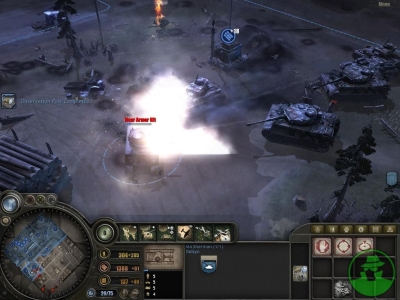How do you define greatness? For me, there's a delicious shiver that runs down my back in the first moment I realize I'm playing something special. It happened the first time I eliminated four lines in Tetris, when I first saw the Cyberdemon in DOOM and the first time SHODAN spoke to me in System Shock 2. When I got the final version of Company of Heroes, I expected it to be good, but I certainly hadn't expected to feel that shiver. But then I saw a German Tiger rumbling through town chewing up virtually everything I had to throw at it. My infantry could barely scratch the paint. It was when I finally figured out how to properly position three Shermans (and quickly lost two of them) to encircle the Tiger that I felt it. To be sure, this is only a first impression of the game (we'll have our full review later this week once we're able to play multiplayer matches against the public), but all indications are that Company of Heroes will be something special.
Those who haven't spent a lot of time playing RTS games may not understand why that incident with the tanks is so important. It's because most of them don't even bother trying to create a realistic relationship between armor and infantry units. Most RTS games allow players to mass enough warm bodies and then kill anything. Company of Heroes offers a much deeper strategic experience. Throw five or six squads of un-enhanced riflemen at a Tiger and all you'll get is a bunch of dead soldiers. The game instead forces the player to counter with realistic tactics based on the historical tendencies of both the Axis and the Allied armies. The best way to take down a Tiger is to have three Shermans surround it, one giving the Tiger something to shoot at while the others (hopefully) have enough time to circle around and hit the tank from the rear. This was exactly the kind of thing the U.S. Army had to do in the real world, and finally mastering the technique was the first of many exhilarating moments I've spent with the game.
The more time I spent with Company of Heroes, the more those satisfying tactical moments kept rushing at me. There was the first time I used suppressive fire to pin down four German squads just to buy me a few seconds to rush in engineers with satchel charges and bring down a building. There was my desperate fight against the German Panzers that I faced with nothing but riflemen until I finally realized that I could actually steal German heavy guns. I was leapfrogging infantry and setting up heavy machine-gun squads to watch every access point only to nearly lose my marbles when the Germans managed to sneak in a sniper. The beauty of Company of Heroes is that it finally brings a realistic sense of small-squad tactics and the necessity for combined arms to an RTS in a way that's easily understandable, mostly manageable and has never been done this well.
Anyone who's familiar with Relic's previous RTS, Warhammer 40,000: Dawn of War, will be instantly familiar with the basic gameplay dynamics of Company of Heroes. The game is an aggressively oriented, squad-based RTS in which players utilize three different types of "command points" to produce a variety of World War II-era ordnance that then gets used to capture pieces of territory and pound the opposing army into unpleasant red stains in the French soil. Squads consist of three to six men and are controlled as a single unit. Each squad or piece of equipment can also be upgraded with special weapons and abilities by using resources. Damaged squads can be "healed" by bringing in reinforcements at their headquarters, an important dynamic, as veteran squads do significantly more damage.






